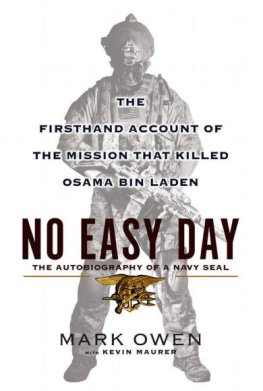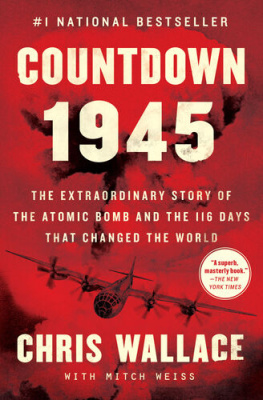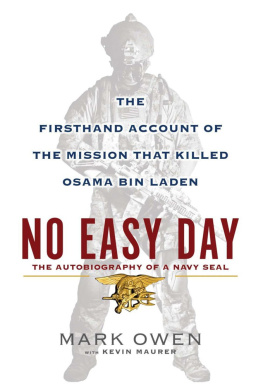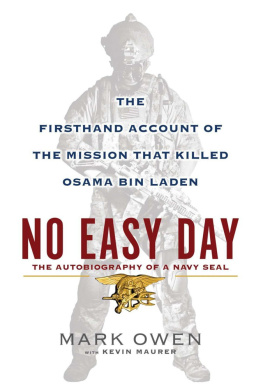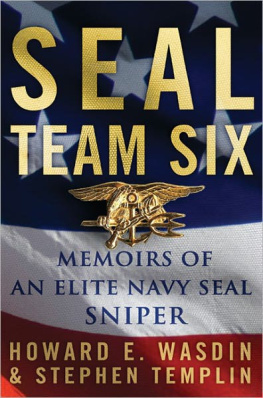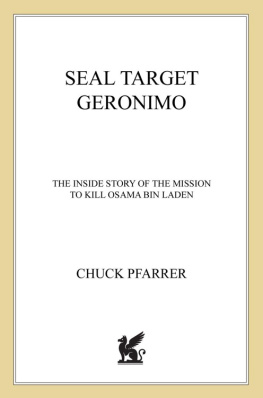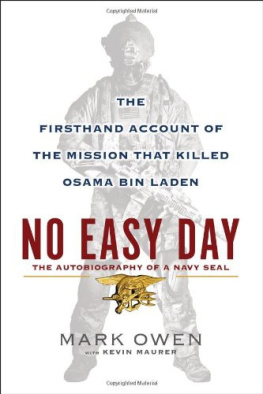
FOR THE RED MEN.
NOW THE WORLD KNOWS WHO YOU ARE.
CONTENTS
By knowing things that exist
you can know what does not exist.
MIYAMOTO MUSASHI
The Book of Five Rings
NEPTUNES SPEAR
THE BIGGER PICTURE
The operation that killed Osama bin Laden was a combined, multiservice effort, carried out by the Joint Special Operations Command, SEAL Team Six, and the Central Intelligence Agency. Code-named Neptunes Spear, it was the quintessential information-age mission, conceived by a Navy admiral who wrote the book on special operations and watched on an Internet link by a president with a Twitter account.
The men who entered Osama bin Ladens compound and brought him to justice were members of the smallest and most elite special operations force in the United States military, the Navy SEALs. The exact number of SEALs deployed worldwide is a closely held secret. It can be told, however, that since World War II, fewer than ten thousand men have earned the right to wear the trident: an eagle, anchor, and flintlock badge that marks a sailor as a fully qualified Navy SEAL.
It takes more than two years of intense, nonstop training to earn the basic SEAL qualification of 5326, combat swimmer. From that point on, a rookie SEAL enters one of the most rigorous meritocracies conceived by man. A SEAL is judged not only by the missions he has undertaken but also by his courage, skill, physical ability, and character. Within this small fraternity a mans reputation is earned solely by his standing as an operator. To rise in the ranks, every SEAL, both officer and enlisted, must demonstrate that he can lead physically in combat, and intellectually in the planning cycle. There is no shortcut to command.
This is the history of the operation that killed Osama bin Laden. It is also the story of the SEAL operators themselves, the daunting challenges they faced, and the ever-evolving and dangerous menace posed by Osama bin Laden and his hell-spawned creation, Al Qaeda.
Osama bin Laden declared war on the United States of America, and for fifteen years terrorists working in his pay killed as many people as they possibly could. Surprisingly, for an organization that declared itself to be at war with Crusaders and Jews, most of Osama bin Ladens victims were Muslims.
In writing this book, certain accommodations have been made to protect operational security and the identity of SEAL Team operators. This is necessary to protect both them and their families. Obscured also are some of the locations of bases and mission elements.
When the government revealed Operation Neptunes Spear, some of the men involved became public figures. I have used their correct names. The names of operational SEALs, past and present, have been changed, as have the names of the intelligence professionals who supported them. I have tried to draw the personalities involved in this mission as accurately as possible. Some of my portraits are frank. In addition, it has been necessary to omit some details of the operation at Bin Ladens compoundso as not to contribute to the tactical understanding of our enemies. The SEALs I have left in shadow, and those serving elsewhere, have the respect and thanks of a grateful nation. I am proud to count myself as a brother.
Every mission the SEALs undertake adds to the corporate knowledge of the team. Neptunes Spear was certainly no exception. In order to comprehend the events at Abbottabad, one has to understand the men who conducted the mission. That includes an appreciation for what it takes to become a SEALa grueling two-and-half-year processand the further, decades-long journey a SEAL operator must make before he can be selected for duty at SEAL Team Six. So difficult is the training process, and so skilled are the operators, that the men of SEAL Team Six are called Jedis. This nickname is hardly an exaggeration.
Several key missions were undertaken by SEAL Team Six before the Bin Laden operation; these included an operation to free the captain of the Maersk Alabama, Richard Phillips, who had been captured by Somali pirates. Another mission was the pursuit and interdiction of Musab al-Zarqawi, Osama bin Ladens handpicked operational commander in Iraq. Both of these operations contributed to the tactical acumen the SEALs brought to Osamas compound. They are recounted here so the reader may judge the men and the organization that accomplished a nearly impossible operation.
This book will also briefly examine the historical currents and intellectual climate that shaped the character of a man who decided to overthrow the world. The reader will forgive a brief diversion into both the history of Islam and the politics of the Middle East.
These subjects were studied intently by the SEAL operators who descended on Bin Ladens compound. For almost ten years, they read his pronouncements and fatwas, researched his operations and plans, listened in on his phone conversations, and traced the flow of his money. They knew their enemy well.
And on the night of May 1, 2011, they came calling.
ABBOTTABAD: MAY 1, 2011LATE THAT NIGHT
ON THE NIGHT THAT OSAMA BIN LADEN was killed, Sohaib Athar could not sleep. The thirty-three-year-old IT consultant had moved his young family to Abbottabad almost six months earlier. Hed come to this quiet city after his wife and son were hit by a car on the teeming streets of Lahore. A physics grad of Forman Christian University, Sohaib also held a master of science from the University of the Punjab. He liked to say that in his previous life he was a start-up specialisthed come to Abbottabad to open a coffee shop and Internet caf. Business was good. His Web site said proudly that his was the first coffee shop in Abbottabad to brew fresh espresso. Sohaib Athar was a quiet man and he wanted a quiet life.
That night, the windows were open in his apartment on the Jadoon Plaza. The heat of the day was slow in breaking, and by midnight, scented wind blew down from the Shimala Hills above the city. Spring was coming to the foothills of the Hindu Kush, and as the days had grown hotter, people were shifting their activity to the evening, when it was cooler. Past midnight, a handful of shops were still open, and now and again a truck would rumble past the dusty strip mall sprawling on either side of Sohaibs balcony. The city of Abbottabad was falling asleep.
Just before one in the morning on May 2, Sohaib heard a buzzing sound; it grew in volume and faded, came in with the wind and left with it. Finally, he could tell it was the noise of a helicopteror maybe a couple of them.
Sohaib looked out the window toward the echoing hills. The night was hazy, and above the glare of the streetlights he could see nothing. The sound came again and then it was gone, like someone had thrown a switch.
He crossed from the balcony to his laptop and logged on to his Twitter account: Helicopter hovering above Abbottabad at 1AM (is a rare event).
Sohaib could have no idea of what was unfolding three miles to the east of his balcony. It was 12:58 a.m., and at a place called Yaba Yar, a team of United States Navy SEALs were jumping from helicopters into the high-walled compound of Osama bin Laden.
A top secret Stealth Hawk helicopter had lost power and crashed after inserting an assault element on the roof of the main building. Later, a Pentagon spokesman would claim that there had been a rough landing but the men who witnessed it, and the others watching overhead monitors knew better.
It was there, hovering above the main building, and then it fell out of the sky. Enveloped in an opaque cloud of dust, 32,000 pounds of top secret American technology slammed into the ground and beat itself to pieces. It took fifteen agonizing seconds for the engines to flame out and for the rotors to stop. During that eternity, broken pieces of aircraft, communications equipment, and flight components were tossed in all directions. The transmission blew itself apart and one of the forty-two-foot-long Kevlar rotors was launched a hundred yards, landing in a field of beans.
Next page

